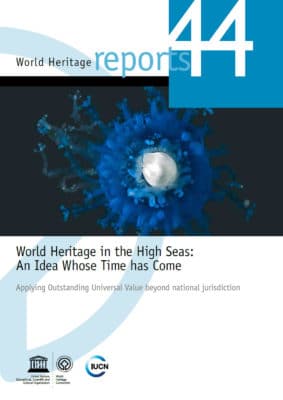World Heritage High Seas Report
(2016)
Embodying our motto Science Without Borders®, the Khaled bin Sultan Living Oceans Foundation has supported the efforts of the UNESCO World Heritage Centre Marine Programme to identify ways in which World Heritage status could be used to protect outstanding places on the High Seas. This project resulted in the publication of this World Heritage High Seas Report by UNESCO and IUCN that proposes multiple ways in which World Heritage status could be used to protect places on the High Seas.
World Heritage in the High Seas: An Idea Whose Time has Come
 UNESCO World Heritage Centre Marine Programme
UNESCO World Heritage Centre Marine Programme
August 3, 2016
By Fanny Douvere
Just as on land, the deepest and most remote ocean harbours globally unique places that deserve recognition, just as we have given to the Grand Canyon National Park in the United States of America, to the Galápagos Islands in Ecuador or the Serengeti National Park of the United Republic of Tanzania. 70% of our planet is covered with ocean. Nearly two-thirds of the ocean lies beyond the jurisdiction of nations. The open ocean is a vast majestic place that covers half our globe.
Imagine a world with sunken fossilized islands covered in a great diversity of corals and other marine life, giant volcanoes forming vast seamounts that can all but dwarf the tallest mountains on land, a ‘floating golden rainforest’ on the ocean surface with its own unique creatures, or even a deep dark place with 60-metre-high white spires of rock that looks like a lost city beneath the waves.
Some of these places are not even powered by the light of the sun, like everything else on Earth, but by heat and energy emerging from the Earth and the ocean ridges, that has created some of the most exceptional ecosystems and species – most still unknown to science. Unique forms of life so extreme they form pivotal case studies for space agencies and others, providing critical analogues to help plan future missions to distant planets to search for life or spur innovation for the next generation of disease treatments. All these, and more, are found in the ‘High Seas’ and the deep seabed – which together we call Marine Areas beyond National Jurisdiction (ABNJ), lying as they do outside the territory of any single nation.
The purpose of this publication is to consider how such exceptional sites could be afforded the same level of recognition and protection that we are currently able to give to natural and cultural sites under the 1972 World Heritage Convention.1 The reason we do not already do so is largely a result of past history but now is the time to expand our horizons and bring such areas into consideration for their potential Outstanding Universal Value (OUV)…